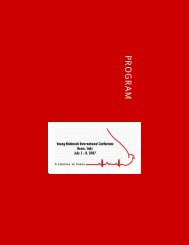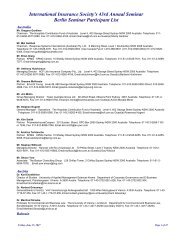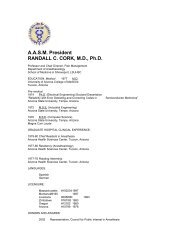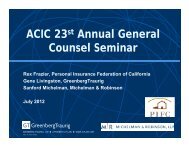Peer Learning and Coaching - Karen Anderson - Hospital ...
Peer Learning and Coaching - Karen Anderson - Hospital ...
Peer Learning and Coaching - Karen Anderson - Hospital ...
Create successful ePaper yourself
Turn your PDF publications into a flip-book with our unique Google optimized e-Paper software.
Collaborative Approach to Improving<br />
Outcomes in Colorectal Surgery<br />
<strong>Karen</strong> <strong>Anderson</strong>, MT, MPH, CIC<br />
Manager, Infection Control & Prevention<br />
California Pacific Medical Center<br />
San Francisco, CA<br />
<strong>and</strong>ersk@sutterhealth.org
Objectives & Background<br />
• GOAL: Reduce adverse outcomes in colorectal<br />
surgeries<br />
• Background<br />
– System approaches have been st<strong>and</strong>ardized: antibiotic<br />
choice, normothermia in OR, & glucose control<br />
– Do other variables exist that may influence outcomes<br />
in colorectal surgery, e.g., bowel prep, use of<br />
preoperative oral antibiotics, anastomotic technique,<br />
<strong>and</strong> wound closure<br />
• Choices are based on custom, training, or the surgeon’s<br />
judgment as to what is best for the individual patient.<br />
2
Barriers & How we Resolved<br />
• Getting surgeons to believe the rates – this<br />
does not happen overnight!<br />
– Use meticulously analyzed data<br />
– Get a surgeon champion – educate them <strong>and</strong><br />
convince them to lead the improvement<br />
• Collaborate: establish a local collaborative or<br />
join one <strong>and</strong> share data <strong>and</strong> results<br />
– identify variability in choices in colorectal surgery<br />
3
Tests & What we Learned<br />
• Surgical site infections (SSI) <strong>and</strong> complication<br />
rates were measured using NSQIP*.<br />
• SSI rates were also measured using NHSN**<br />
• Our rates were high<br />
• Variability in some processes existed<br />
*National Surgical Quality Improvement Project<br />
**National Healthcare Safety Network<br />
4
Measures – What & How<br />
• Measured surgical site infection rates <strong>and</strong> other<br />
complications using NHSN & NSQIP<br />
• Created questionnaire that surgeons complete for each<br />
surgery to identify 18 additional variables such as:<br />
– preoperative oral antibiotics in the 24hrs prior to surgery<br />
– non-emergent surgery<br />
– laparoscopic approach<br />
– mechanical bowel preparation<br />
– Entereg administration<br />
• Analyzed variables for statistical significance<br />
5
Operation <strong>and</strong> Surgeon controlled data<br />
on the questionnaire
Five variables are associated with<br />
Anastomotic Leak <strong>and</strong>/or OS-SSI (p
Wrap Up & Next Steps<br />
• The collaboration of local hospitals has been<br />
successful<br />
• Going forward:<br />
– Welcome additional collaborators<br />
– Increase our sample size<br />
– Continue to reduce missing data elements from<br />
questionnaires<br />
– Apply more sophisticated statistics (e.g., general <strong>and</strong><br />
hierarchical linear modeling, Classification And<br />
Regression Trees +/- propensity scoring)
Advice for others<br />
• Data must be accurate <strong>and</strong> convincing to elicit<br />
change<br />
– Know your data backwards <strong>and</strong> forwards<br />
• Be able to succinctly give your message<br />
• Get a surgeon on board who will be the<br />
spokesperson<br />
• Get surgeons to agree on st<strong>and</strong>ardization, as<br />
much as possible<br />
• Strength in numbers - collaborate with local<br />
hospitals (local influence has greater impact than<br />
national – your own backyard concept)<br />
10







